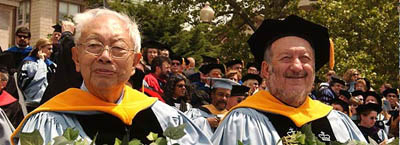Chu Receives Honorary Doctor of Science Degree
 As one of only seven mathematicians to receive an honorary degree in Columbia’s 252-year history, C. K. (John) Chu is both humbled by the company he is in and, he says, unduly honored by the distinction. A pioneer in computational mathematics, Professor Chu’s work in fluid dynamics, magnetohydrodynamics and shock waves has garnered him international recognition while his zeal for his life’s work prompted him to work tirelessly to create a home for applied mathematics at Columbia.
As one of only seven mathematicians to receive an honorary degree in Columbia’s 252-year history, C. K. (John) Chu is both humbled by the company he is in and, he says, unduly honored by the distinction. A pioneer in computational mathematics, Professor Chu’s work in fluid dynamics, magnetohydrodynamics and shock waves has garnered him international recognition while his zeal for his life’s work prompted him to work tirelessly to create a home for applied mathematics at Columbia.
The son of parents with various degrees of Western education-his father received an MBA from NYU in 1929 and his mother spoke fluent English- he was born in Shanghai. He graduated in 1944 from St. John’s University High School, where the curriculum was half Chinese and half English. He was accepted at St. John’s University but decided to take the entrance examination for Chiaotung (now Jiaotong) University, the national science and engineering university.
“I didn’t think I had much of a chance, but I got in,” he said. After doing extremely well in his university studies, Chu came to the United States for graduate work. He received his master’s degree in 1950 from Cornell and accepted a job as an engineer at General Electric. “I was happy at GE,” he said, “and was all set in a special advanced program for engineers. And then, in 1953, a major incident occurred.”
That incident was a telephone call from Professor Chu’s advisor at Cornell, who had moved to Stevens Institute of Technology, offering him a position as an assistant professor there. The selling point was that Professor Chu would be near the Courant Institute of Mathematical Sciences. “On Friday, I interviewed for and accepted the position at Stevens and, on the following Monday, I interviewed with Richard Courant. He asked me what I needed for a salary and I said, 'I suppose if they are offering me an assistant professorship, my answer to you should be zero.’ I was accepted as a Ph.D. student and it changed my life.”
In 1959, he became the first Chinese student to receive a Ph.D. from Courant Institute. He taught at Pratt Institute and NYU Engineering before joining the Columbia Engineering faculty in 1963 as a visiting research scientist in the plasma physics laboratory. Within four years, he had been granted tenure and, a year later, was named a full professor. In 1999, he was named Fu Foundation Professor of Applied Mathematics. As a theoretician working with plasma physics, he was delighted when then dean Peter Likins asked him to form a new program in applied mathematics as a successor to the Mathematical Methods program already functioning well under Prof. Morton Friedman. Its first home was in Applied Physics and, in 1997, the name of the department was changed to Applied Physics and Applied Mathematics, fully recognizing the program.
Professor Chu recalls two exceptionally strong students, Robert Merton ’66 and Stephen H. Schneider ’66, ’71. Merton is a Nobel Laureate in economics and Schneider is professor of environmental biology and global change at Stanford and a MacArthur Fellow (the “Genius Award”).
Professor Chu, whose advice and guidance has helped hundreds of students for more than four decades, retired in 2003 but he still maintains contact with most of his 24 Ph.D. students and many of his former undergraduate students.
